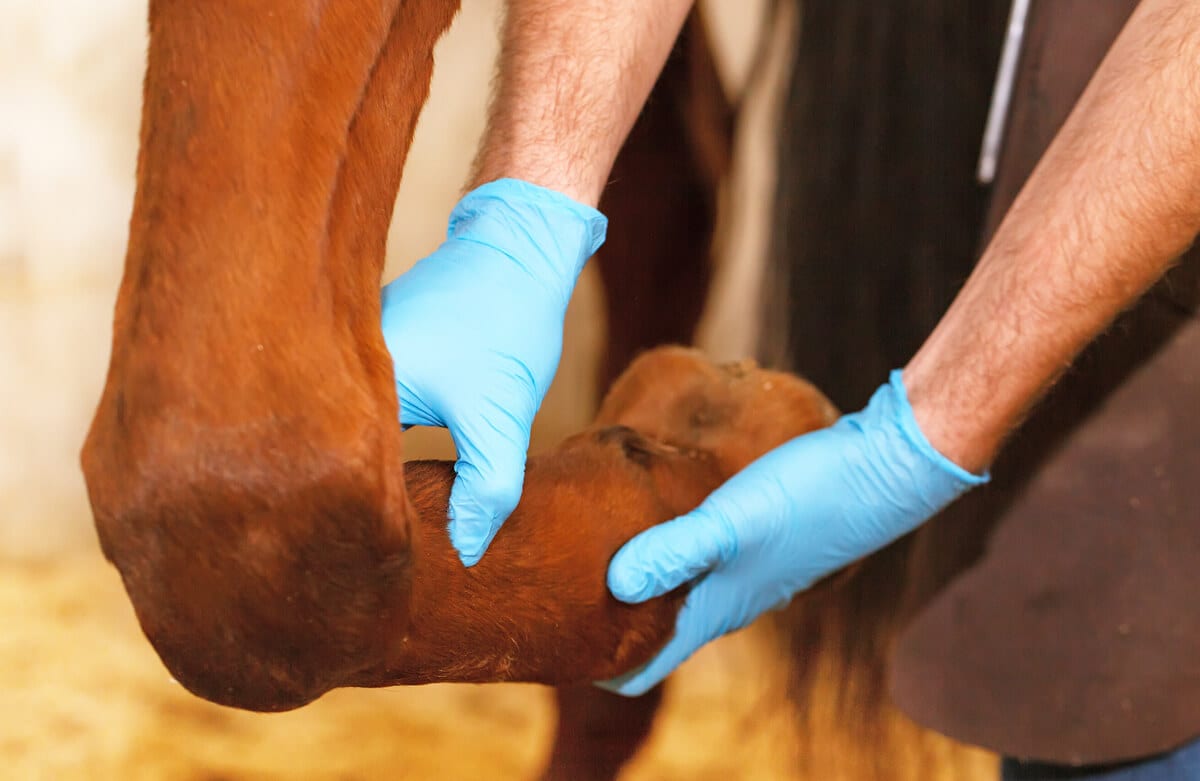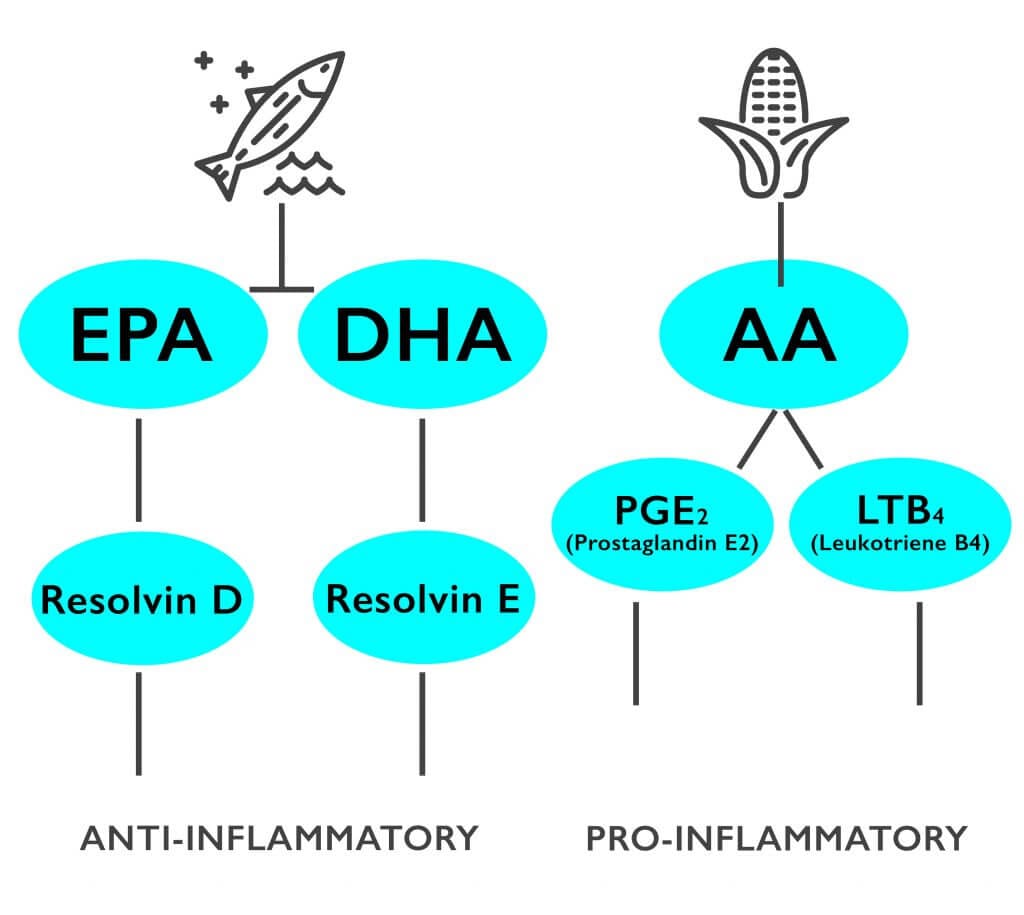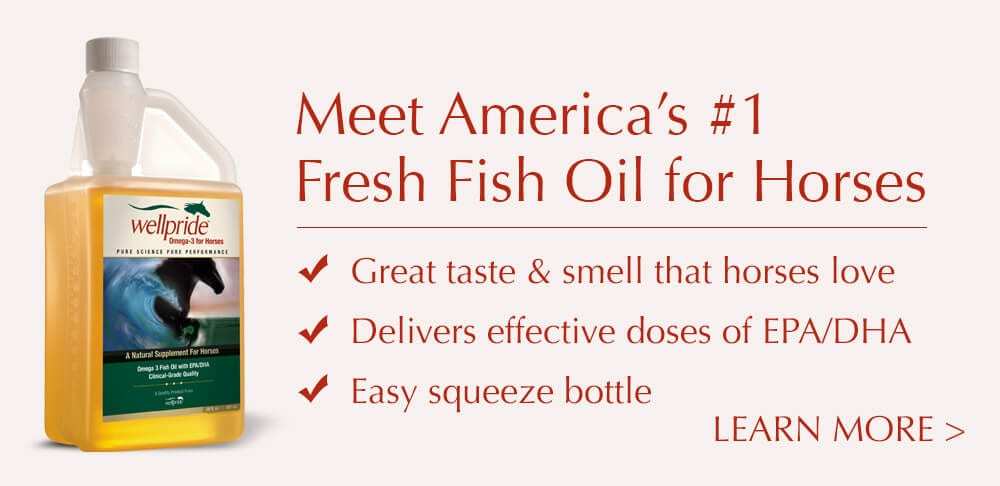How Omega-3s Can Benefit Horses with Osteoarthritis
Most people don’t own horses just to look at them. Our aim is to ride, with many having high hopes for their mount’s success in competition.
In such an athletic animal as the horse, osteoarthritis can be a devastating diagnosis, and quite an expensive one. However, there are ways to help prevent osteoarthritis, as well as support horses that end up with the condition. One helpful tool may include supplementing with omega-3 fatty acids, particularly from fish oil.
What Causes Osteoarthritis in Horses?
Among horse owners, osteoarthritis might also be called degenerative joint disease, DJD, or just simply ‘arthritis.’ In research articles, arthritic joints are described as resulting from previous damage to the cartilage of the joint, wear and tear due to exercise, and the natural aging process (1).
In younger horses, the body produces new articular cartilage at its highest rate, letting the horse quickly and easily heal damaged joint tissue. However, with age or overuse, the breakdown of old cartilage can overpower the rate at which new, healthy cartilage is produced. This imbalance, along with changes in the underlying bones and other joint tissues, can lead to osteoarthritis.
The Chronic Inflammation at the Heart of Arthritis
Recently, researchers have started to emphasize the importance of both preventing and directly addressing the degenerative mechanisms that contribute to arthritis, rather than simply treating osteoarthritis symptoms with anti-inflammatory drugs (also known as NSAIDs). After all, long term NSAID use can cause gastrointestinal side effects. In addition, certain organizations, such as U.S. Equestrian (formerly USEF) and the International Equestrian Federation (FEI), place restrictions on NSAIDs and other medications for events under their jurisdiction and use drug testing to ensure that competitors follow the regulations.
Some researchers have specifically looked at how correcting the imbalance between omega-6s and omega-3s could help prevent and slow the progression of osteoarthritis:
How Omega-6s Fuel Inflammation
In an effort to start the healing process after injury or overuse of a joint, the body orders a cascade of inflammatory cytokines and eicosanoids to get into action. Derived from omega-6s, the responsibility of these molecules is to create inflammation and indirectly say to the horse, “Hey, you need to take it easy so we can get your joint back into shape.”
But here’s the catch. Today, most animals (including horses) intake far too much omega-6 in the form of corn oil, safflower oil, soybean oil or canola oil, either through eating processed feeds or by receiving these oils as a fat supplement. As a result, the body is constantly flooded with pro-inflammatory eicosanoids. This overabundance of omega-6s can transform what started out as well-intended healing signals into chronic inflammation. And chronic inflammation not only manifests itself as uncomfortable swelling, stiffness and pain, but can also contribute to the breakdown of cartilage.
How Omega-3s Fight Inflammation & Protect Cartilage
Omega-3s are a part of every cell in the body. They act as gatekeepers to the cell, regulating the exchange of nutrients and signals across the cell membrane. And these fatty acids have other important roles as well.
Two types of omega-3s — eicosapentaenoic acid (EPA) and docosahexaenoic acid (DHA), which are found plentifully in our Wellpride oil — compete with omega-6 fatty acids for storage in the cell membrane, as well as during metabolism. When the body gets enough omega-3s, these fatty acids can reduce the expression of cartilage-degrading enzymes, as well as produce anti-inflammatory eicosanoids (2). For instance, EPA and DHA are the substrates to important anti-inflammatory molecules called resolvins and protectins. These mediators do exactly what their names imply; they resolve and protect against further inflammation. And indeed, cell studies have shown that resolvins and protectins have positive effects on cartilage (3).
Omega-3s, like EPA and DHA, produce molecules that help fight inflammation. In contrast, omega-6s, like AA, flood the body with pro-inflammatory enzymes.
What Equine Studies Show
There are relatively few studies that have looked at how EPA and DHA fatty acids influence horses with osteoarthritis — at least compared to the research done in humans and other animals. However, a few studies have looked at how omega-3s influence the expression of certain cartilage-degrading enzymes.
In a 2016 article in Veterinary Practice News titled “What You Need to Know About Omega-3 Fatty Acid Supplements for Horses” veterinarian Stacey Oke, DVM, MSc, shared, “Recent studies…show that omega-3 fatty acids should be a staple in the realm of joint supplements.”
She referenced a study by McIlwraith and colleagues done in 2015 (4) that looked at whether dietary supplementation with omega-3s would affect experimentally induced synovitis in horses. Six mares were given the control diet while six other mares were given an omega-3-enriched diet containing 40 g/day of omega-3s for 91 days. On day 91, joint inflammation was artificially created. A 90-day feeding period of an omega-3-rich diet increased blood serum phospholipid and synovial fluid lipid compositions of EPA and DHA compared to the control group.
“We showed that you could inhibit some of the critical enzymes,” says McIlwraith, adding that more research is needed.
After supplementation, there was no difference in the two groups in the levels of most inflammatory mediators or markers of joint disease. However, the treatment group did show a significant decrease in a catabolic enzyme that frequently appears in equine joint tissues. These results indicate that omega 3 supplementation might improve the joint’s response to inflammation and provide some protection to the cartilage.
A 2009 study done at Texas A&M University (5) on 16 mature horses with arthritis of the knee, fetlock, hock or stifle joints showed that omega-3 supplemented horses had lower levels of white blood cells in synovial fluid and fibrinogen and prostaglandin E2 in plasma than the control group. These results suggest that supplementation reduced these indicators of joint inflammation and may benefit geriatric horses with osteoarthritis or performance horses who are in a high-impact, high-stress training regimen.
Using Fish Oil as an Equine Joint Supplement
If you are considering upping your horse’s omega-3 intake, it is important to note that not all omega-3 sources are alike. Only a few types of foods — fish, fish oil and breast milk, to be specific — contain all the different members of the omega-3 fatty acid family, including the most important EPA and DHA molecules. Plant sources, like flaxseed, only contain the omega-3 fatty acid ALA.
In addition, research has shown that the anti-inflammatory benefits of omega-3 fatty acids are dose dependent. Or, to put it in other words, results depend on getting enough omega-3s.
Why Choose Wellpride for Your Horse
When we started Wellpride back in 2003, we worked with a team of equine-focused DVMs to look at how fish oil would impact racing horses prone to ulcers, EIPH and arthritis. We also measured the horses’ omega-3 index levels to understand how the oil would be absorbed and to estimate the omega-3 dose necessary to make a measurable difference.
The results were as predicted: The horses recovered faster after racing and needed fewer NSAIDs. In addition, their coats looked healthier after the trainers started using Wellpride.
We also realized that, just as in human medicine, the impact of an omega-3 supplement will depend on the dose and the quality of the oil. That is why today, we use a fresh, human-grade oil for Wellpride. Since our pioneering work 15 years ago, many have tried to copy our oil, but often without understanding that dose and quality are essential to getting results.
If you have any questions about Wellpride, we encourage you to contact us or leave a comment below.
References:
1. Manhart, D. R. (2007 Aug) Effect of N-3 PUFAs on Markers of Inflammation in Arthritic Horses. Texas A&M University.
2. Vandeweerd, J., Coisnon, C., Clegg, P., Cambier, C., Pierson, A., Hontoir, F., Saegerman, C., Gustin, P. and Buczinski, S. (2012) Systematic Review of Efficacy of Nutraceuticals to Alleviate Clinical Signs of Osteoarthritis.J Vet Intern Med, 26: 448-456.
3. Ioan-Facsinay, A. and Kloppenburg, M. (2018 Jan) Bioactive lipids in osteoarthritis: risk or benefit? Curr Opin Rheumatol 30(1):108-113.
4. Ross-Jones, T.N., McIlwraith, C.W., Kisiday, J.D., Hess, T.M., Hansen, D.K., and Black, J. (2016 Jun) Influence of an n-3 long-chain polyunsaturated fatty acid-enriched diet on experimentally induced synovitis in horses. J Anim Physiol Anim Nutr, 100(3):565-77.
5. Manhart, D.R., B.D. Scott, P.G. Gibbs, J.A. Coverdale, E.M. Miller, C.M. Honnas, and D.M. Hood. (2009) Markers of inflammation in arthritic horses fed omega-3 fatty acids. Professional Animal Scientist 25:155-160.







